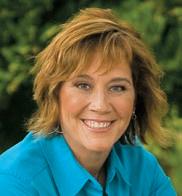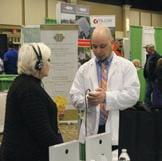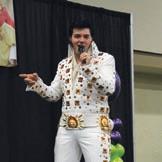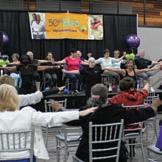















You probably are aware that comedian Jay Leno, an avid car collector and host of the show Jay Leno’s Garage, suffered burns on his face, hands, and chest in November.
While working on one of his many cars, gasoline leaked and caught fire, resulting in a mixture of second- and third-degree burns. Leno, 72, underwent several skin grafts and spent eight hours daily in a hyperbaric chamber to expedite the healing process.

He recently joked about his garage accident in the Wall Street Journal, where he wrote, “Eight days later, I had a brand-new face. And it’s better than what was there before.”
All joking aside, burns are serious and even deadly. National Burn Awareness Week, Feb. 5-11, is sponsored by the American Burn Association (ameriburn. org). This nonprofit organization aims to stimulate and advance burn-related research, education, care, prevention, and rehabilitation.
Burns are classified as either first, second, or third degree. First-degree burns affect only the outer layer of the skin, leaving the skin red and painful. Second-degree burns leave the skin blistered and swollen, in addition to redness and pain. Third-degree burns destroy the epidermis and the dermis, sometimes affecting the bones, muscles, and tendons.
The proper treatment for first-degree burns is to immerse the site in cool water. Second- and third-degree burns require immediate medical treatment at a hospital or burn center. Some third-degree burns require skin grafts, a surgical procedure involving removing a thin layer of skin from an unburned part of the body to cover a burned area.
In the United States, one person sustains a burn every 60 seconds. Every year, about 400,000 people receive medical treatment for burns. Most burns occur in the home, with 47% of fires caused by cooking.
Adults 65 and older are at a higher risk of injury and death from a kitchen fire because of physical, visual, hearing, or mental impairments that may slow a quick action necessary in a fire emergency. The thinner skin of older adults burns faster and deeper.
Preventing a burn injury is better than the pain and trauma of medical treatment afterward. Injuries and fatalities can be avoided with safety devices and precautions.
For example, home sprinkler systems cut the risk of dying in a fire by 80%. A fire extinguisher is a valuable tool. Smoke alarms, fire-escape routes, and education on cooking and smoking safety are necessary safeguards.
According to the Consumer Product Safety Commission, unattended cooking is the No. 1 cause of fires at home. Older adults sometimes forget to turn the stove off or may not realize their clothing has caught fire. These tips help you stay safe:
• Always “stand by the pan” — never leave food unattended. Stay in the kitchen while frying, broiling, or grilling food. If you leave the room, turn off the stove.
• Check regularly if you are simmering, baking, roasting, or boiling food.
• When heating food in the microwave, use microwave-safe cookware that allows steam to escape. Allow food to rest before removing it from the microwave.
• Turn the pot handles toward the back of the stove to prevent accidental bumping.

• Keep areas around the stove clear of items that can burn.
• Wear oven mitts or use potholders.
• Be extra careful when deep frying. Use a pan lid or splash guard to prevent grease splatter.
• Gradually heat cooking oils.
• Wear shirts with tight or short sleeves. Exposed skin may burn, and long, loose sleeves are more apt to catch fire.
• Keep baking soda handy.
• After cooking, check the kitchen to ensure all burners and other appliances are turned off.
If food does catch on fire:
1. Cover the pan with its lid. A cookie sheet works too. Leave covered until the pan is cool. Never move the pot or carry it outside — the pot is too hot to handle, and the contents may splash, causing a severe burn.
2. Turn the heat off. The fire should quickly put itself out with the lid on and the heat off. Never use water to put out a kitchen fire as it will cause the oil to splatter and spread the fire or scald you as it vaporizes.
3. If the fire is inside the oven or microwave, keep the door shut and turn it off. Keep closed until the oven is cool.
4. If the fire gets out of control — get out, stay outside, and call 9-1-1. Don’t return inside for any reason.
CoRPoRAtE oFFICE
P.O. Box 8049, Lancaster, PA 17604
Phone (717) 285-1350
(610) 675-6240
Fax (717) 285-1360
Email address: info@onlinepub.com
Website address: www.onlinepub.com
PRESIDENt AND PUBLISHER
Donna K. Anderson
EDItoRIAL
Vice President and Managing Editor
Christianne Rupp
Editor, 50plus Publications

Megan Joyce
ARt DEPARtMENt
Project Coordinator
Lauren Phillips
BUSINESS DEVELoPMENt
Senior Marketing Consultant
Joshua Binkley
Events Manager
Kimberly Shaffer
ADMINIStRAtIoN
Business Manager
Elizabeth Duvall
 By Kimberly Blaker
By Kimberly Blaker
For nearly 250 years, America held Black men, women, and children as slaves. They were considered “property” and worked as servants and on plantations, not by choice, and for little compensation, often suffering severe abuse.
Despite progress, today, Black Americans still experience prejudice. During Black History Month, the nation celebrates African Americans, both young and old, who fought for freedom and civil rights.
The legalized slave trade ended in 1808. But slaves continued to be smuggled into the United States, and the millions already held in servitude found no relief.
Member of
took a gradual pace, with some Southern political leaders creating laws that kept Blacks from voting and legalized segregation.
During this time, the Ku Klux Klan took matters into its own hands. From 1889 to 1918, the Klan captured and hung 3,224 men, women, and children, mostly Black.
In 1905, W.E.B. Du Bois wrote: “We claim for ourselves every single right that belongs to a freeborn American — political, civil, social; and until we get these rights we will never cease to protest and assail the ears of America. The battle we wage is not for ourselves but for all true Americans.”

Awards
Nearly two years into the Civil War, on Jan. 1, 1863, President Abraham Lincoln issued his Emancipation Proclamation, declaring all slaves held by the Confederate states “shall be forever free of their servitude, and not again held as slaves.”
Slaveholders released few slaves immediately. But two years later, the South surrendered, and the 13th Amendment was ratified, abolishing slavery.
In 1868, the 14th Amendment was ratified, giving U.S. citizenship to Blacks and guaranteeing equal protection under the law. Then in 1870, the 15th Amendment gave them the right to vote.
President Ulysses S. Grant signed the Civil Rights Act in 1875, guaranteeing African Americans equal rights in public accommodations and jury duty. But the progress was short lived. In 1883, the Supreme Court ruled the act unconstitutional.
Over the following decades, societal change
Out of his letter came a civil rights organization called the Niagara Movement. It lasted only five years, but it led to the formation of the National Association for the Advancement of Colored People (NAACP) in 1910.


Around the mid-1900s, the pace of the civil rights movement took off. In 1948, President Harry Truman created a Civil Rights Commission. He called for an end to school segregation and proclaimed a fair employment policy for federal workers.
Over the next few years, state Supreme Courts heard school segregation cases. Not all were successful. But on May 17, 1954, the United States Supreme Court made a ruling. In Brown v. Board of Education of Topeka, the court ruled school segregation is unconstitutional.
The next decade was turbulent. Many whites refused to accept that Black and white children would attend school together. Bus boycotts and other peaceful demonstrations by Blacks and civil rights activists met with acts of violence by those who favored segregation.
Then, in 1964, President Lyndon B. Johnson signed a new Civil Rights Act. It outlawed discrimination in voting and public accommodations and required fair employment practices. In 1965, the Voting Rights Act was passed, barring the use of literacy and other tests as a requirement to vote.

The following men and women are just some who challenged the system and led the way to reform.
Sojourner Truth (1797?-1883) escaped slavery and became a traveling preacher. She was a talented orator and, in 1843, became the first Black woman to speak out against slavery. Later, Truth strove to improve the conditions for Black people who settled in Washington, D.C.
Nat Turner (1800-31) led a massive slave revolt in Virginia in 1831 known as the “Southampton Insurrection.” Nearly 60 white people were killed. Turner and many of his followers were later captured and hanged. Nonetheless, he became a symbol for abolition.
Harriet Tubman (1820-1913) escaped slavery in 1849. She helped free more than 300 slaves through the Underground Railroad and served as a spy and a nurse during the Civil War. Later she helped raise funds for African American schools and advocated for women’s rights.
Booker T. Washington (1856-1915) headed and expanded the Tuskegee Institute in Alabama, a college for Black students. He believed that Black economic independence was necessary to gain social equality. His autobiography, Up from Slavery, was published in 1901.
W.E.B. Du Bois (1868-1963) founded the NAACP. His goals included ending segregation and the widespread lynching that was taking place in the United States. Du Bois also visualized world change.
He was the author of many works, including Black Reconstruction (1935). In 1961, he moved to Ghana and joined the Communist Party after becoming alienated from the United States. He later died “in self-imposed exile.”

Thurgood Marshall (1908-93) was the first Black United States Supreme Court judge. Before taking the seat, he served as director of the NAACP’s Legal Defense and Education Fund. Marshall appeared before the Supreme Court in Brown v. Board of Education in 1954 and other monumental civil rights cases.
James Leonard Farmer (1920-99) founded the Congress of Racial Equality (CORE) in 1942. He and his organization favored nonviolent protests.
Rosa Lee Parks (1913-2005) was arrested in 1955 after refusing to give up her bus seat to a white man. This led to the Montgomery bus boycott, which facilitated the national civil rights movement. In 1979, she won the Spingarn Medal for her courageous contribution.
Malcolm X (1925-65) became a Black Muslim minister after he converted to Islam. An influential leader, in 1964 he broke away from the movement to form the Organization of Afro-American Unity. He was assassinated in 1965, presumably by rival Black Muslims.
Martin Luther King Jr. (1929-68) is one of America’s most noted civil rights leaders. His leadership included organizing the 1955 bus boycott in Montgomery, Alabama. Over the years, King was arrested 30 times for his peaceful civil rights activities. King’s extraordinary leadership led to the Civil Rights Act of 1965. In 1968, he was assassinated.
Andrew Young (b. 1932) assisted in drafting the Civil Rights Act of 1964 and the Voting Rights Act of 1965. He also served as the first African American U.S. ambassador to the United Nations.

Belinda Rochelle explains in her book, Witnesses to Freedom: Young People Who Fought for Civil Rights, that kids also made valuable contributions.
On April 23, 1951, high school student Barbara Johns led a boycott at R.R. Morton High School over the Black school’s poor conditions.
The Morton students rode an unheated school bus to school. They also had to wear heavy winter coats to classes to keep warm, and the school’s textbooks and classrooms were in poor condition.
A month following the boycott, a lawsuit was filed against the school district.



Another high school student, Harvey Gantt, was a senior when he organized a sit-in demonstration. He and other Black students walked into a segregated diner to be served. Instead, they were immediately taken to jail.

Gantt became the first Black student to enroll in the segregated Clemson University of South Carolina.
Sheyann Webb was only 8 when she became involved in the movement. On March 7, 1965, the little girl participated in what became known as Bloody Sunday. In this demonstration, 600 people began a 54-mile march from Selma to Montgomery, Alabama, in response to the death of a Black man killed in a fight with the police.

On Bloody Sunday, officers attacked the marchers, including children, during the demonstration. Many were beaten and injured. Sheyann escaped the worst of the day, suffering only from the tear gas she encountered.
As an adult, she’s traveled the country advocating for education and discussing the civil rights movement.
While each of these men, women, and children played a crucial role in the movement, they did not do it alone. Millions of Americans throughout history have taken part in the cause.
Dear Savvy Senior,
I started a walking program a few months ago to help me lose weight, but I’ve been having problems with my legs and hips hurting during my walk, although they feel better once I stop.
I thought it was just because I’m getting old, but my neighbor was telling me about a leg vein disease she has called PAD and thinks I may have something similar. What can you tell me about this?
– Limping Linda
Dear Linda,
The health condition your neighbor is telling you about is known as “peripheral arterial disease” (or PAD), which is an under-the-radar disease that affects approximately 8 million to 12 million Americans. It happens when the arteries that carry blood to the legs and feet become narrowed or clogged over the years with fatty deposits or plaque, causing poor circulation.
But you also need to be aware that because PAD is a systemic disease, people who have it are also much
• Your focused message reaches its targeted audience.

• Multi-venue promotion — online, in print, and through social media platforms.

• Year-round distribution — annual Women’s Expos and 50 plus EXPOs, local offices of aging, and other popular venues.

more likely to have clogged arteries in other areas of the body like the heart, neck, and brain, which greatly increase the risks of heart attack or stroke.
Unfortunately, PAD goes undiagnosed and untreated way too often because most people who have it experience few, if any, symptoms.
The most common symptom, however, is similar to what you’re experiencing: pain and cramping in the hip, thigh, or calf muscles, especially when walking or exercising. It usually disappears after resting for a few minutes.
Another reason PAD is underdiagnosed is because many people assume aches and pains go along with aging and simply live with it instead of reporting it to their doctor.

Other possible symptoms to be aware of include leg numbness or weakness, coldness or skin color changes in the lower legs and feet, or ulcers or sores on the legs or feet that don’t heal.
Like most other health conditions, the risk of developing PAD increases with age.
Those most vulnerable are people over the age of 50 who smoke or used to smoke; have elevated cholesterol, high blood pressure, or diabetes; are overweight; or have a family history of PAD, heart attack, or stroke. African Americans are also twice as likely to have PAD as Caucasians.

If you’re experiencing any symptoms or if you’re at increased risk of PAD, you need to be tested by your doctor or a vascular specialist.
He or she will probably perform a quick and painless ankle-brachial index test, which is done by measuring your blood pressure in your ankle as well as your arm and comparing the two numbers.
Your doctor may also do imaging tests, such as ultrasound, magnetic resonance angiography (MRA), and computed tomographic (CT) angiography.

With early detection, many cases of PAD can be treated with lifestyle modifications including an improved diet, increased physical activity, and smoking cessation.
If lifestyle changes aren’t enough, your doctor may also prescribe medicine to prevent blood clots, lower blood pressure and cholesterol, and control pain and other symptoms.
And for severe PAD, the treatment options are angioplasty (inflating and then removing a tiny balloon in the artery to restore blood flow), the insertion of a stent to reopen the artery, or a graft bypass to reroute blood around the blockage.
To learn more about PAD, visit the National Heart, Lung, and Blood Institute at nhlbi.nih.gov/health/peripheral-artery-disease.



Solutions for all puzzles can be found on page 18.









The AARP Foundation TaxAide Program is again offering free tax service for York County taxpayers, especially adults 50 and older with low or moderate income, during the 2023 tax season.
There is no fee and AARP membership is not required.
Taxpayers should bring their photo ID and proof of Social Security or ITIN numbers for anyone on the tax return, including children or other claimed dependents. Also, last year’s tax return is helpful if available.
AARP Tax-Aide volunteers can prepare most personal income tax returns, including those with basic self-employment income.

They are not trained to do business returns such as corporate, partnership, limited partnership, farm income, or rental income.
Appointments can be made by calling the following locations or online at yorkaarptaxaide.com

• Aldersgate United Methodist Church, York – (717) 771-9042
• Delta Senior Center – (717) 456-5753
• Dover Township Library – (717) 292-6814


• Hanover Church of the Brethren – (717) 633-6353

• Living Word Community Church, Red Lion – (717) 771-9042
• Messiah United Methodist Church, York – (717) 771-9042
• Red Land Senior Center, Lewisberry – (717) 938-4649
• St. Matthew Lutheran Church, York – (717) 771-9042
• Shrewsbury Grace United Methodist Church – (717) 993-3488
• Susquehanna Senior Center, Craley – (717) 640-5006
• Trinity Lutheran Church, Wrightsville – (717) 640-5006
• Union Fire Company, Manchester – (717) 771-9042
• Windy Hill on the Campus, Spring Grove – (717) 640-5006
• York Alliance Church – (717) 771-9042
Last year in York County, nearly 100 volunteers filed more than 3,800 federal, state, and local income tax returns at 16 different county locations.
Dunlin, sanderlings, ruddy turnstones, and purple sandpipers are small shorebirds that nest on the Arctic tundra. However, many individuals of each kind winter along the Atlantic Ocean coasts of New Jersey, Delaware, Maryland, and farther south.

Happily, each species has its own winter niche along that shoreline. That spreading of these related shorebirds reduces competition for invertebrate food among them, though there is some overlapping of niches.

Each kind of shorebird is camouflaged on its winter habitat. They are not usually seen until they move or fly, which protects them from hawks and other predators.
Flocks of dunlin, a type of sandpiper that is brown on top, feed on invertebrates in saltmarsh mudflats when the tide is out, exposing the mud. Each bird repeatedly pokes its beak into the mud to pull out aquatic worms and other tidbits until the saltwater comes back and floods the flats again.
All day, every day in winter, little groups of pale-gray sanderlings, a kind of sandpiper, rapidly run after saltwater sweeping down sandy beaches to the Atlantic Ocean. These sandpipers do that to pick up and consume invertebrates the retreating water leaves behind on the exposed sand.
The sanderlings then turn around and run up the beaches ahead of the next incoming wavelets sliding up the beaches. And when each wavelet’s advance is halted by gravity, those sandpipers turn again and follow the receding water down the beaches, picking up invertebrates along the way.
Ruddy turnstones, which are a kind of plover, mostly winter in small gatherings on gravelly shores near the Atlantic coast. These handsome, distinctly brown-and-white-patterned shorebirds have the interesting habit of flipping over small stones in search of invertebrates lurking under them.




Dusky-feathered purple sandpipers winter on dark, wave-battered boulders and rock jetties on the Atlantic coastline. Jetties are human-made walls of boulders that jut into the ocean from the beaches and protect the beaches from pummeling ocean waves.
Little groups of purple sandpipers walk over the boulders, and the mussels and seaweed clinging to them, in search of invertebrates to consume. Pounding ocean waves are the worst danger to purple sandpipers.
These shorebirds are interesting to spot along the Atlantic Coast in winter. Each species is camouflaged in its own winter niche, where the birds hunt invertebrates until spring stirs their hormones to migrate north to the Arctic tundra to raise young.
Every member of the Taylor family found something of interest and entertainment. Bob tried his hand at the miniature golf course and checked his accuracy throwing an axe at a target.
His wife, Evelyn, searched for the bald eagles that like to hang out along the nearby lake, and then took in a show at the comedy club. Their son, Roger, preferred to speed around the GoKart track and do his best to avoid getting hit on the bumper car ride.


The fact the Taylors found all of these activities at one place was unusual. What made it even more different was they were spending time at a shopping mall.
For decades, malls have been primarily for shopping and perhaps enjoying a snack at a restaurant. Today, they have become destinations of their own, where customers may spend time having fun as they spend their money.




The growth of suburbs and rise of the automobile culture in the mid-20th century launched an explosion of shopping malls away from inner cities and into the residential neighborhoods that sprung up around them. In the 1990s, close to 150 malls sprung up each year. Then came online shopping. Malls that had been go-to places suddenly seemed out of date.
Hundreds have closed their doors in recent years, and professor Mark Cohen, a retail business specialist at the University of Columbia, predicts that, of the approximately 1,000 malls still operating, half will be gone within five to six years.

Rather than accepting this outlook without a fight, some mall owners have been combating the trend by adding new attractions that can appeal to people of all ages and many interests. That includes the Taylors.

They were hanging out at Destiny USA (destinyusa.com), a massive shopping, entertainment, and dining venue near Syracuse, New York. It welcomes more than 26 million guests each year and has its own ZIP code and onsite hotel.


In addition to the activities that appeal to the Taylors, it offers a bowling alley, laser tag, a science and technology attraction, an escape room, an interactive mystery theater, and an antique carousel constructed in 1909.




In an effort to reduce the impact of such an active infrastructure on the environment, Destiny USA follows a number of practices earning it Gold Certification for Leadership and Environmental Design, the largest commercial retail building in the world to be so honored.
The Mall of America in Twin Cities, Minnesota (mallofamerica.com), is also known for efforts to reduce waste and follow sustainable practices. These include growing 30,000 plants and 400 trees for air purification, having over a mile of skylights for passive solar energy, and recycling tons of food waste for local hog farmers. Entertainment there includes a 27-ride theme park, a 1.3-million-gallon aquarium containing 10,000 sea creatures, and a flight simulation tour of the United States. People entering the Escape Game are challenged with getting out of prison and stealing back a famous painting from the thief who had pilfered it.
An aquarium is also a feature at American Dream in New Jersey (americandream.com). Its “City under the Sea” includes an underwater tunnel featuring some of New York City’s most famous landmarks. LEGO fans love the Legoland Discovery Center in Philadelphia, Pennsylvania (legolanddiscoverycenter.com), a veritable indoor LEGO playground. Visitors can jump on the Imagination Express for an interactive tour of a world inhabited by larger-than-life LEGO characters or participate in activities at the Build Challenge Arena.
Some malls offer pursuits geared to folks seeking a bit of physical activity. That’s true at The Galleria in Houston, Texas (simon.com/mall/the-galleria). “Polar Ice” is a full-size ice-skating rink, which in 1970 was the first built inside a mall. Nearby are swimming pools and a jogging track that runs around the roof.
Even more energetic activities challenge participants during Fitness Fridays at The Outlet Collection mall in Seattle, Washington (outletcollectionseattle. com). They offer an energetic dance experience, combining fitness with fun. But that’s just for starters at this grouping of discount stores. Among other activities are occasional blood donation drives, hazardous-waste disposal collections, and celebrations of events like World Kindness Day, as well as recent recognition of Native American Heritage Month featuring displays by the local Muckleshoot tribe.
Some malls are well worth a visit for their architecture alone, and that includes The Arcade in Cleveland, Ohio (theclevelandarcade.com). Once dubbed the Crystal Palace, it was considered to be an architectural tour de


force when it opened in 1890.

Other centers double as gardens and art galleries. Palm Court in Miami, Florida, is a plaza that incorporates native species of palm trees from Florida and the Caribbean into its landscape. Located in the city’s Design District (miamidesigndistrict. net), it’s lined with a collection of public art. The focus is the iconic geodesic dome, designed by the renowned architect Buckminster Fuller.
These are just a few of the many sites around the United States that continue to give new meaning to the words “shopping mall.”


After gallivanting around the world, Victor Block still retains the travel bug. He believes that travel is the best possible education. A member of the Society of American Travel Writers, Victor loves to explore new destinations and cultures, and his stories about them have won a number of writing awards.


In 2022, we saw a really eclectic mix of newly approved medications that covered all sorts of diseases and will no doubt generate billions of dollars over the next five years.


Many of these are new drugs that have been highly anticipated. Hopefully, there is something I list below that will help you or someone you love.
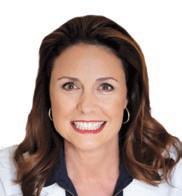
My column is printed in various languages, but I’m only using English brand names, so please ask a pharmacist in your region for brand names available to you.
Quviviq® (daridorexant) tablets, Rx: This drug is intended for adults with insomnia. It should not be used if you have serious liver problems or if you do not intend to lie in bed for seven hours.
It will, like all other sleep medications on the market, leave you feeling a little woozy in the morning, so don’t jump out of bed without acclimating
properly. Of course, do not operate machinery or drive, either!
Never combine this drug with alcohol or other sedatives and certainly not with sedative-hypnotic drugs, like alprazolam or zolpidem!
Cibinqo® (Abrocitinib) tablets, Rx: This medication is a JAK inhibitor, and it’s useful for people who have atopic dermatitis, sometimes called eczema. Contraindications to this medication include having low levels of lymphocytes, neutrophils, red blood cells, or platelets. I like JAK inhibitors as a general rule. There are weaker, natural herbal options, which I will write about later. Do not take this medication if you

In September 1965, both Variety and the Hollywood Reporter ran an attention-grabbing advertisement:
Madness! Auditions. Folk and Roll Musicians –Singers for acting roles in new TV series. Running parts for four insane boys, age 17-21.
From the 437 hopeful applicants, coveted roles were assigned to Mike Nesmith (22), Peter Tork (23), Mickey Dolenz (20), and Davy Jones (19).

The Monkees were created to ride the slipstream of Beatlemania and were hired to mimic the Beatles’ zany antics in A Hard Day’s Night, their 1964 semi-documentary debut flick. The Monkees’ TV plotline involved a struggling rock quartet in search of their Big Break.
A well-received TV pilot was filmed in late 1965, and in early 1966 NBC-TV picked up The Monkees as a weekly primetime series.
The four young men then embarked on a grueling schedule of improv classes, band rehearsals, and filming. Early on, Monkees members were limited to vocal work, with only professional session musicians providing the instrumental music.

The Monkees, a half-hour show, hit big when it debuted in September 1966. Tunesmiths Tommy Boyce and Bobby Hart wrote the band’s first 45 (a No. 1 winner): “Last Train to Clarksville” featured a chord structure, jangly guitar lines, and vocal harmonies lifted directly from the Beatles’ “Paperback Writer.”
The Boyce-Hart team would eventually create three more winning singles. Other professional songwriters (including Neil Diamond and Carole King) were rushed in to keep the hits flowing. The Monkees’ eponymous debut album also skyrocketed to the top of the Billboard charts.
The Prefab Four (as sneering cynics often labeled them) were off and running.
APPRoVALS from facing page
Elucirem™ (Gadopiclenol) a nd Vueway® (gadopiclenol) injections, Rx: If you are allergic to iodine-based contrast, these two new options are handy to have. Contrast agents make it easier for the doctor to “see” inside your body. These drugs might be harmful to the kidneys.
These two new agents are supposedly better than the older gadolinium-based agents, which is good because I’ve seen the harm done by those older ones! If you’d like to read my blog about older gadolinium agents, I have it posted at my website.
Omlonti® (Omidenepag ) eye drops, Rx: These drops treat glaucoma and ocular hypertension and could certainly be used in conjunction with herbal/ vitamin remedies that support eye health.
By that December, growing pressure led the Monkees to begin touring, with each member hurrying to master his instrument well enough to perform onstage.
No problem, as it turned out, since, akin to the Beatles’ shows, much of the music played was lost to the eardrum-piercing screams that tsunami-ed in nightly from the vast teenybopper audiences. Making music was better than faking music, and the Monkees’ men worked hard to improve. In January 1967, a mere four months after “Clarksville” introduced them to the world, the Monkees held their first recording session as a fully functioning, self-contained band.
The Monkees TV show, though, was another issue entirely. By the end of the second season, the quartet had tired of the filming grind and pronounced the third-season scripts monotonous and stale.
When they suggested a format change to a one-hour variety show, their idea was quickly squelched and the series was axed, which undoubtedly crushed countless teenage hearts.
During their two-year reign, though, when the foursome often successfully challenged the almighty Beatles, the Monkees sold more than 75 million records around the world.
Had they been just a bubblegum fantasy quartet, one that was never quite real, undeserving of any real respect?
Not to everybody. Vanity Fair writer Mark Rozzo once opined, “They were a pop culture force … They created joy and wonderment and introduced the whole realm of pop music to a huge audience of young people.”
Eye color may change over months to years, and it’s permanent. Faster lash growth may occur too.
Elahere® (Mirvetuximab soravtansine-gynx) injection, Rx: This medication is used to treat resistant cases of ovarian or fallopian tube cancer (also peritoneal cancer).
It may cause neuropathy or eye problems, but it can help people who are resistant to platinum therapy or prior chemotherapy treatments.
I have a longer version of this article with more medications that were approved this past year. That is available at my website, suzycohen.com
This information is not intended to diagnose, prevent, or treat your disease. For more information about the author, visit suzycohen.com.
bethany Village
325 Wesley Drive Mechanicsburg, PA 17055
Stephanie Lightfoot
Director of Sales & Marketing (717) 766-0279
slightfoot@asbury.org
www.bethanyvillage.org

cornwall manor P.O. Box 125 Cornwall, PA 17016
Jennifer Margut
VP for Marketing & Public Relations (717) 274-8092
marketing@cornwallmanor.org www.cornwallmanor.org
homeland center 1901 North Fifth Street Harrisburg, PA 17102 (717) 221-7900
jmurray@homelandcenter.org www.homelandcenter.org
homestead Village 1800 Village Circle Lancaster, PA 17603
Christina Gallagher (717) 397-4831
cgallagher@hvillage.org
www.homesteadvillage.org

willow Valley communities 600 Willow Valley Square Lancaster, PA 17602
Margie Seagers Manager of Sales (717) 464-6800
info@willowvalley.org
Yes
Listings with a screened background have additional information about their services in a display advertisement in this edition.
This is not an all-inclusive list of agencies and providers. The CCRCs listed are sponsoring this message. These advertisers are eager to provide additional information about their services.
certifications and comments:
living community of energetic people who truly care about one another.
Homeland’s proud tradition of exceptional care includes a vibrant personal care and five-star skilled nursing home, along with community outreach services throughout south-central Pennsylvania.
Premier 55+




stoneridge retirement living communities


Popular Run – (717) 866-3200


Church of God – (717) 866-3200
Towne Center – (717) 866-3200
Schoolyard Square – (717) 866-3200
Kristine Tobias
Director of Independent Living & Sales kristine.tobias@stoneridgeretirement.com www.stoneridgeretirement.com
united church of christ homes
Ephrata Manor – (717) 738-4940
Kindred Place at Annville – (717) 867-5572
Kindred Place at Harrisburg – (717) 657-7900
The Lebanon Valley Home – (717) 867-4467
Sarah A. Todd Memorial Home – (717) 245-2187
Thornwald Home – (717) 249-4118
Victoria Velez
Director of PR & Fund Development (717) 303-1502

vvelez@ucc-homes.org www.ucc-homes.org
Listings with a screened background have additional information about their services in a display advertisement in this edition.
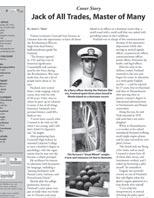


This is not an all-inclusive list of agencies and providers. The CCRCs listed are sponsoring this message. These advertisers are eager to provide additional information about their services.
certifications and comments:
Part of your community since 1924, StoneRidge has been creating senior living environments and communities that are designed to enhance the bonds and benefits of community as we continue to follow Christ’s loving example through our mission and our core values.

Honoring the uniqueness of each person, residents of United Church of Christ Homes receive individual care and attention based on specific needs, preferences, and interests. We offer a place to be yourself and celebrate your life!
If you would like to be featured on this important page, please contact your marketing consultant or call (717) 285-1350.


“Valentine” was a common, gender-neutral name during the third to sixth centuries. It is of Latin origin and means “strong and healthy.”

“Valentine” was the name of a third-century Christian martyr and saint whose feast falls on Feb. 14, the traditional date celebrating spring. He is the patron saint of lovers, epileptics, and beekeepers. Pope Gelasius I declared Valentine’s Day in 496 AD, when he proclaimed the day the Feast of St. Valentine.
While St. Valentine suggests God’s unconditional love, it was only much later that Valentine’s Day became associated with love at all. In fact, Valentine’s Day as a lovers’ festival dates from the 14th century.

Where does Cupid fit into this
story? Greek mythology (around 700 BC) had the legend of Eros, god of desire.

Eros was the son of Aphrodite, the goddess of love, and was considered both handsome and threatening. He would cause mayhem with the hearts of men, using his power to make people fall into ruinous love. Circa 440 BC, Eros’ power is described as sinister.
When the Roman era began (around 31 BC), the ruling class adopted Greek mythology. This included the image of a cherub, whom they named Cupid and who served as Eros’ counterpart. Centuries later, Renaissance painters depicted the Cupid figure as a young, nude boy with wings and a bow. They attributed Cupid with a




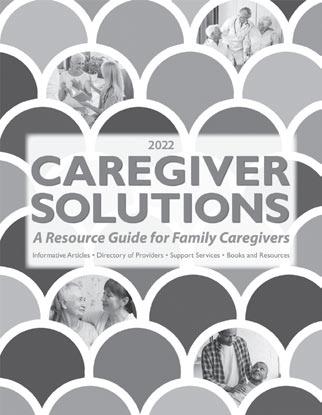
Q. When I visit certain webpages, a video starts playing automatically. Is there a way to disable this annoying behavior?
A. The simple answer is yes, there is probably a setting you can adjust to stop most videos from automatically playing. Where things can get messy is finding the right setting. Chrome, Edge, Firefox, and Safari each have preferences that block video auto-play everywhere, and they can also selectively block auto-play on specific sites. These options can be found in the browser’s preference (settings) screen, under the heading Privacy or Media, depending on the browser.
The story for mobile devices adds another wrinkle. Mobile devices are usually on cellular data plans. Videos, even short ones, can consume your data allowance fast. In addition to the advice above about web browsers, also look for options to prevent loading video while using cellular networks.
Annoying auto-play behavior is not limited to browsers. Apps like Facebook and Instagram can consume tremendous amounts of data by automatically showing video and high-res photos. These kinds of apps usually have settings that let you trim their appetite for data, with the added benefit of stopping most auto-play behavior.

The bottom line is that most videos can be silenced automatically. But it will take some patience to configure the right settings for your device.
VALENtINES from facing page
positive intent in promoting love.
During the Middle Ages, Feb. 14 was associated with the beginning of birds’ mating season, thus the link with romance. In 1415, the first written Valentine’s Day card is attributed to Charles, Duke of Orleans, who penned a poem to his wife while imprisoned in the Tower of London.
The first commercially made Valentine cards were produced in 1849 in Massachusetts. In the 1860s, Richard Cadbury, of Cadbury Chocolates, England, was the first to package chocolates in heart-shaped boxes to increase sales.
Cadbury originally sold cocoa for drinking. They introduced the first chocolate to be eaten, but the recipe was unpalatable by today’s standards. The Cadbury brothers removed the starchy materials, and in 1897 they introduced the milk chocolate we know today.
The greeting-card industry took off in the 1850s after Congress voted to decrease postage rates to avoid the privatization of the postal service. Mass-printing machines and lower postal costs made it possible for everyday Americans to send and receive mail, typically postcards.
In 1910, Joyce C. Hall and his brother founded a
Q. I have an older smartphone I no longer use, but it has photos that I would love to see again. Can I copy the images to a new phone?
A. Check out the PhotoStick line of products. They have models that work with computers and smartphones. The smartphone versions are available at getphotostickmobile.io.
The phone cannot be too old. And it has to turn on and hold a charge long enough to copy the photos off it. It also requires a compatible connector, such as iPhone’s lightning port or USB on Android.

If these requirements are met, you can insert a PhotoStick into the phone’s connector and it will make a copy of all the photos on the device.
PhotoStick is reusable, which is handy if you have more than one smartphone.
One mild downside is that PhotoStick will copy every image. So it might sweep up odd images you do not want. It avoids making duplicate copies of the same image, and there is always a chance that an image might be missed.
But overall it is a reasonably easy-to-use tool that can rescue photos from an out-of-date phone.
postcard company in Kansas City: the Hall Brothers Co. When postcard sales declined around 1916, they printed their own high-quality Valentine and Christmas cards to be mailed in envelopes. In 1954 they changed their name to Hallmark Cards.
Worldwide, about 1 billion cards are sent annually for Valentine’s Day (not including children’s classroom cards). Nearly 85% are sold to women.
Spending on the expression of affection in the U.S. totaled $23.9 billion in 2022, which included $6.2 billion for jewelry and over $2 billion for candy, mostly chocolate. Flowers, gift cards, food treats, wine, and personalized items or experiences are popular.
Within this buying frenzy, Cupid’s reputation and imagery remain a mainstay in the expression of love and friendship. They are imbedded in the commercialization of Valentine’s Day. An alternative this year: Be love.
Doris Montag is a homespun historian and an exhibit curator who researches and displays historical collections of ordinary things, such as can openers, crochet, toy sewing machines, hand corn planters, powder compacts, egg cartons, and more. Contact or follow her on Facebook, HistoryofOrdinaryThings.

Danielle (name changed by request), 74, recently emailed, “I have been reading your articles for years. Partly because of your encouragement, I recently found love in my 70s online. I’d like your opinion regarding a new relationship I’m in.
“For seniors, it is hit or miss with internet dating sites. I was on and off different sites for 12 years. Before online dating evolved, I met a man from a newspaper ad. That relationship lasted 10 years.



“Recently, I was online for only a month. I saw the profile of a man, 68, living in the town next to where I live. He mentioned that he didn’t drink, which is important to me.
“What I did differently this time was have my picture taken at a department store, so when men asked me how recent my picture was, I could honestly say, ‘It’s current.’
“I contacted him. We met for coffee and hit it off right away. We’ve been together for four months. He is the kindest man I have ever met. For Christmas, he gave me a 55-inch smart TV with a beautiful stand and emerald-anddiamond earrings.
“For my birthday in October, he gave me a diamond-chip necklace. I thought the expensive gifts meant the relationship was getting stronger.
“However, there has been a change. He was at my house this evening, mounting the TV on the wall. Imagine my surprise when he said he would be more comfortable if we would only see each other twice a week, sometimes three times a week.
“The only time he ever lived with a woman was when he was married, and that was a long time ago. He has lived alone in his house for 22 years. I guess he is a loner and interested in only having a part-time girlfriend. If a relationship seems too good to be true, sometimes it is.
“I am going to still see him because I’d rather be with someone kind and generous part-time than the unknown. What’s your opinion?”
Tom’s reply to Danielle:
1. I like your attitude, enthusiasm, and wisdom. I agree with your decision
to stay with him. And who knows? As he appreciates you more, he may say, ‘Three days a week, and occasionally four days.’ He wouldn’t have given you those incredible gifts if he didn’t care.
2. Senior love is challenging, sometimes difficult, and different when compared to our younger years. All of us bring baggage into a new relationship. For example, exspouses could be still lingering or kids or grandkids could present challenges. Or, we may have health issues. Is he OK with your age difference?

3. Most single seniors — not all — don’t want to get married again (some have never married). Most want to stay in their own home if they are blessed enough to own one. LAT (living apart together) relationships are becoming more and more common among seniors.
4. Single seniors don’t need to be together daily. Most cherish their independence — but not to the degree that it damages their relationships.

5. We don’t want drama. We want fun and happiness.
6. However, we demand an exclusive relationship. Are you certain he isn’t married or seeing someone else?
7. Most older adults love hugs. One thing almost all of us crave is having a warm, affectionate, caring, understanding, communicative, and huggable mate. We want and need companionship. And you have that with this man.
8. Let the relationship be for now. Appreciate him. Roll with the flow and keep an eye on how the relationship progresses. If warning signs or red flags surface, you may have a difficult decision to make.
For dating information, previous articles, or to sign up for Tom’s complimentary, weekly e-newsletter, go to findingloveafter50.com.
It’s no surprise that succulents, including cacti, are popular. These easy-care houseplants come in a variety of colors, shapes, and sizes, making them perfect for any home.
All you need is a lot of light and benign neglect to raise healthy and beautiful succulents. Place the plants near an unobstructed south-, west-, or east-facing window.
Don’t let a lack of light stop you from enjoying these beautiful plants in your home. You’ll find many attractive options for displaying your plants while providing the light they need.
A single desktop LED plant light, attractive plant-light shelves and carts, and furniture-grade light gardens allow you to grow these sun-lovers anywhere in your home. Grow these plants in cacti and succulent potting mix. These fast-draining mixes help reduce the risk of overwatering, which can lead to root rot. Further reduce this risk by using containers with drainage holes that are only slightly larger than the succulents’ root system. Growing them in too large of a container that retains moisture longer can result in root rot, decline, and even the death of your plants.
Water thoroughly whenever the top inch or two of soil is dry. Some gardeners check the soil moisture at the drain hole to ensure it is dry and the plants need to be watered. Always pour off any excess water that collects in the saucer.
Don’t allow water to collect in the rosette of leaves or the cluster of prickly stems, which can lead to crown rot. Use a watering can like the Haws Indoor Watering Can, which has a long, narrow spout that allows you to reach under the plants to water just the soil.
Make slight adjustments in your watering regime and growing environment

The York County Area Agency on Aging has moved from its location on Market Street to 2401 Pleasant Valley Road, York.
Programs and services will remain the same, and phone and email will have not changed: (717) 771-9610 and aging@yorkcountypa.gov.
as the seasons change. Adapting to changing conditions will keep your plants healthy and looking their best year-round.
Find a cool, sunny, draftfree location for your cacti and succulents in the fall and winter. Maximize the amount of light the plants receive by moving them to the sunniest, usually south-facing, window in your home.
Water thoroughly but only when the top few inches of soil are dry and just often enough to keep the plants from shriveling. These changes in the growing conditions often encourage a spring display of colorful and unique flowers.
Boost your succulents’ natural beauty by displaying them in unique containers or places in your home. Create a living wall display with a three-tier vertical wall planter (gardeners.com) or Mini Magnetic Galvanized Planter Pockets.
Grow a succulent centerpiece that can be enjoyed year-round. Plant a variety of succulents in a long, narrow planter like the Veradek GEO Series Planter boxes. Display it on the table, and if needed, move it back to its sunny location between dinner parties.

Small containers, like the heart-shaped concrete tabletop planters, allow you to create an attractive dish garden even when space is limited.
Whether you’re a busy, experienced, or new indoor gardener, creating a succulent garden may be just what you need to brighten your home and elevate your mood.
Melinda Myers has written more than 20 gardening books, including Small Space Gardening. She hosts The Great Courses’ How to Grow Anything DVD series and the Melinda’s Garden Moment TV and radio program. Myers is a columnist and contributing editor for Birds & Blooms magazine. melindamyers.com
